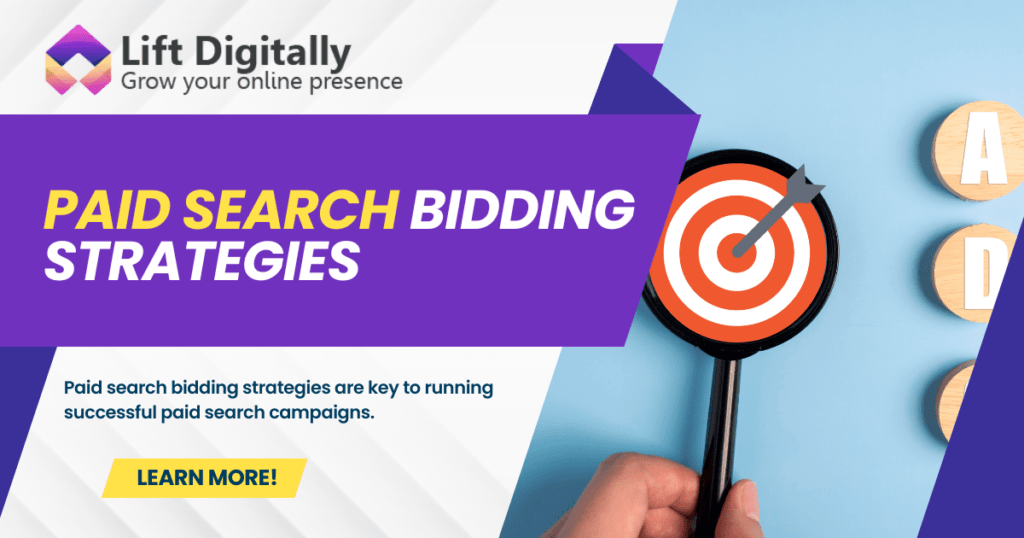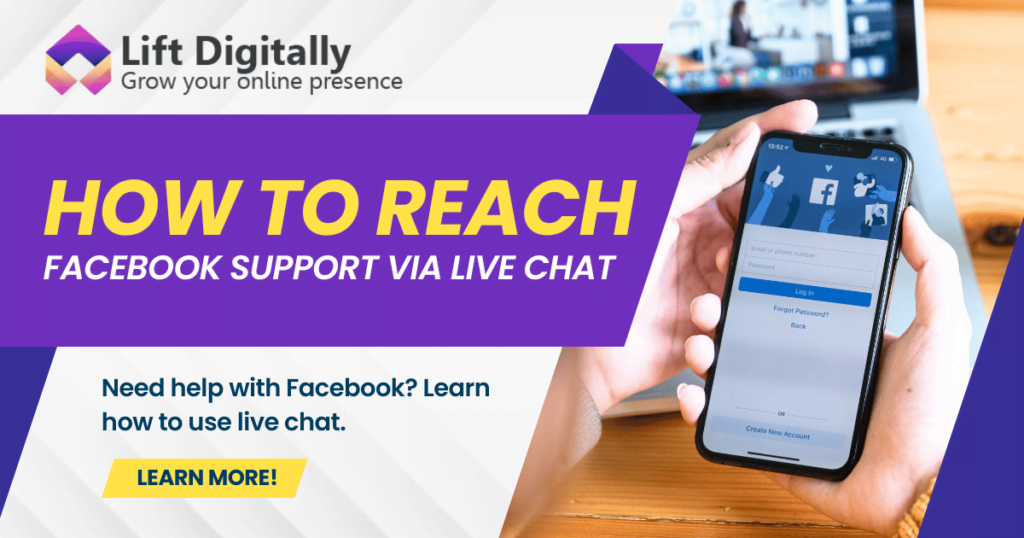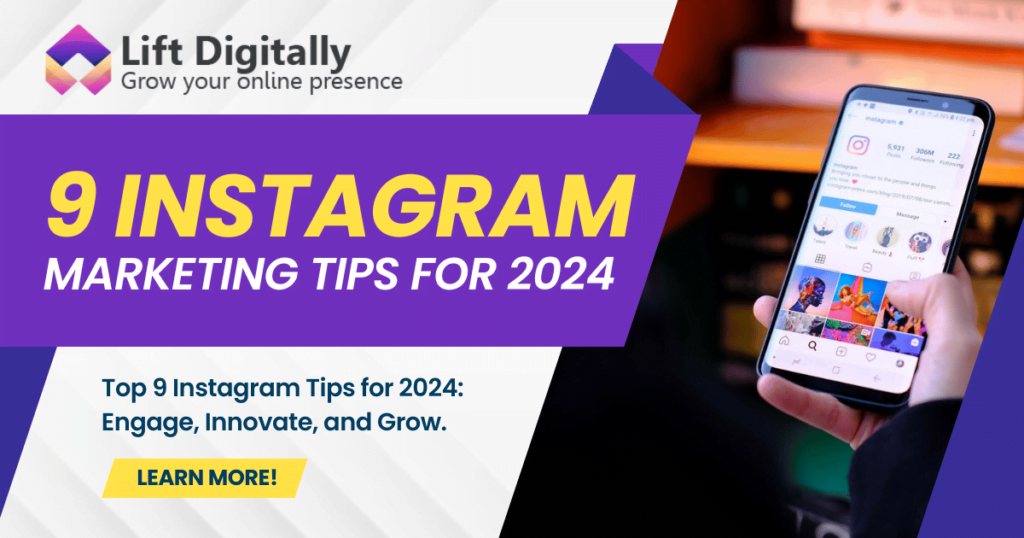Paid search bidding strategies are key to running successful paid search campaigns.
While having compelling ads and an effective landing page is important, selecting the right bidding strategy that aligns with your goals is crucial. Without it, you could end up wasting money or missing out on potential ROI.
Let’s dive into how you can get this right.
In this article, we’ll cover the fundamentals of paid bidding strategies and best practices for developing a PPC bid strategy.
We’ll also share real-life examples of how the Lift Digitally team used different bidding strategies to boost our clients’ revenue, increase conversions, and lower their cost per acquisition.
Understanding Paid Bidding Strategies
If you’re looking to improve your paid search marketing, understanding how bidding works is essential.
Here’s a quick overview:
In paid search, a bid is the amount you’re willing to pay for a click on your ad.
Your bid amount, along with other factors, determines your Ad Rank, which Google uses to decide where your ads appear on the page. These other factors include:
- Quality Score: Google rates your ad and landing page from 1-10 based on expected clickthrough rate, relevance, and landing page experience. Use tools like the free Ads Grader to assess your ad’s performance.
- Search Context: Factors like the user’s device and location.
- Auction Competitiveness: How many other ads and search results are competing.
- Additional Assets: Elements like phone numbers in your ad
Higher placements generally lead to more clicks and conversions. So, should you always bid high? Not exactly.
High bids can quickly deplete your budget, resulting in a high cost per acquisition. For instance, paying $5 per click isn’t viable if your average order value is only $15; you would need an unrealistic conversion rate to make a profit.
And if your goal is brand awareness, high bids may not be the best strategy. Thankfully, there are various ways to bid for ads.
A bidding strategy aligns your bids with your objectives, whether it’s driving more sales, increasing brand awareness, or achieving a specific cost per click (CPC). Google offers over a dozen bidding strategies, and each ad network has its own options.
By understanding and implementing the right bidding strategies, you can optimize your ad spend and achieve your campaign goals.
Understanding Google Ads Bidding Types
Google Ads offers three main bidding strategies: manual bidding, automated bidding, and smart bidding
Manual Bidding
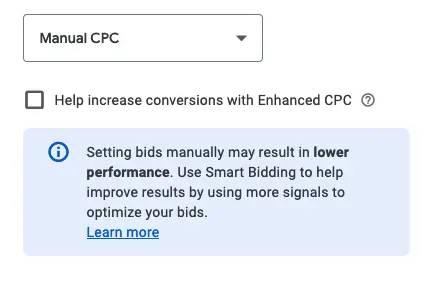
Manual bidding puts you in the driver’s seat of your paid search campaign. You set bids for each keyword, adjusting them for factors like location, time, and device. This strategy requires constant monitoring and can be time-consuming. While it’s great for those with a small budget or extensive experience in managing campaigns, it demands ongoing attention and effort.
Automated Bidding
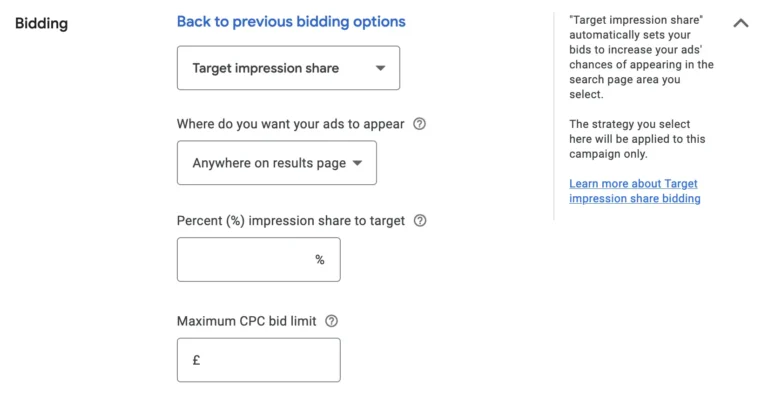
Automated bidding leverages machine learning to adjust keyword and ad group bids based on your campaign goals. Google optimizes your bids to maximize clicks, reach a target impression share, or achieve other predefined objectives. This strategy reduces the manual workload, allowing you to focus on other aspects of your marketing efforts. However, it involves giving up some control, which might not appeal to seasoned marketers.
Smart Bidding
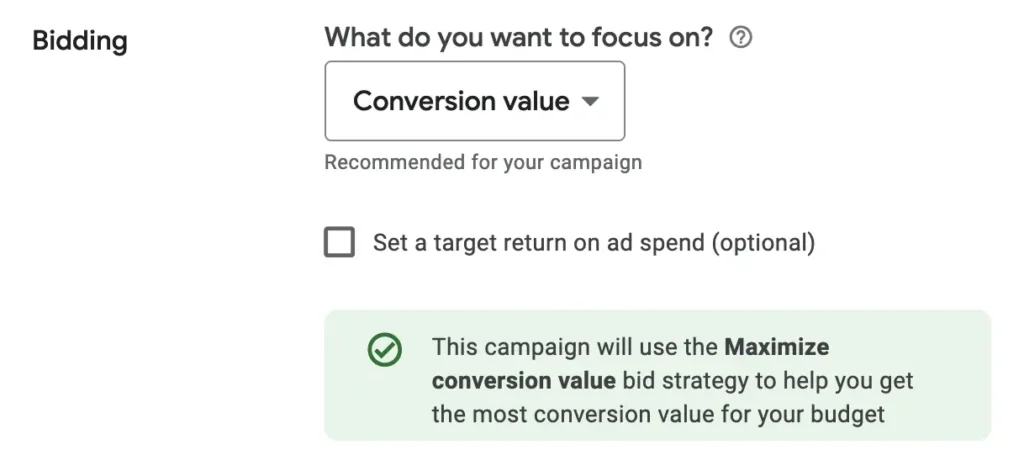
Smart bidding, a subset of automated bidding, uses advanced algorithms to optimize bids for conversions or conversion value at the time of the auction. This means Google adjusts bids in real-time to help you achieve the best possible results, whether that’s more sales or higher profit.
Smart bidding strategies include:
- Enhanced CPC (Cost Per Click): Adjusts manual bids for clicks that are more likely to convert.
- Target CPA (Cost Per Acquisition): Aims to achieve a set cost per acquisition.
- Target ROAS (Return on Ad Spend): Targets a specific return on ad spend.
This approach simplifies the bidding process, making it easier for anyone to run profitable PPC campaigns, even without extensive prior experience.
By understanding these bidding types, you can choose the strategy that best fits your needs and helps you achieve your marketing goals effectively.
Best Practices for Paid Bidding Strategies
Before diving into how my team uses PPC bidding strategies, let’s go over four best practices that are essential, regardless of the strategy you choose.
Ensure Accurate Conversion Tracking
Even the best bidding strategy won’t deliver results if your ad account isn’t tracking conversions correctly. Setting up conversion tracking can be complex, but it’s crucial to ensure your efforts are effective.
To check your conversion tracking in Google Ads:
- Go to the Goals tab in the sidebar
- Click Summary under Conversions.
Here, you’ll see your conversions with one of these statuses:
- Unverified: Google hasn’t verified your tag yet.
- No recent conversions: Verified, but no conversions recorded in the past seven days.
- Recording conversions: Conversions recorded in the past seven days.
- Tag inactive: Google can’t find your tag.
- Removed: The conversion action has been removed.

If your conversions aren’t tracking correctly, Google provides troubleshooting instructions. Click the blue Troubleshoot button for help.
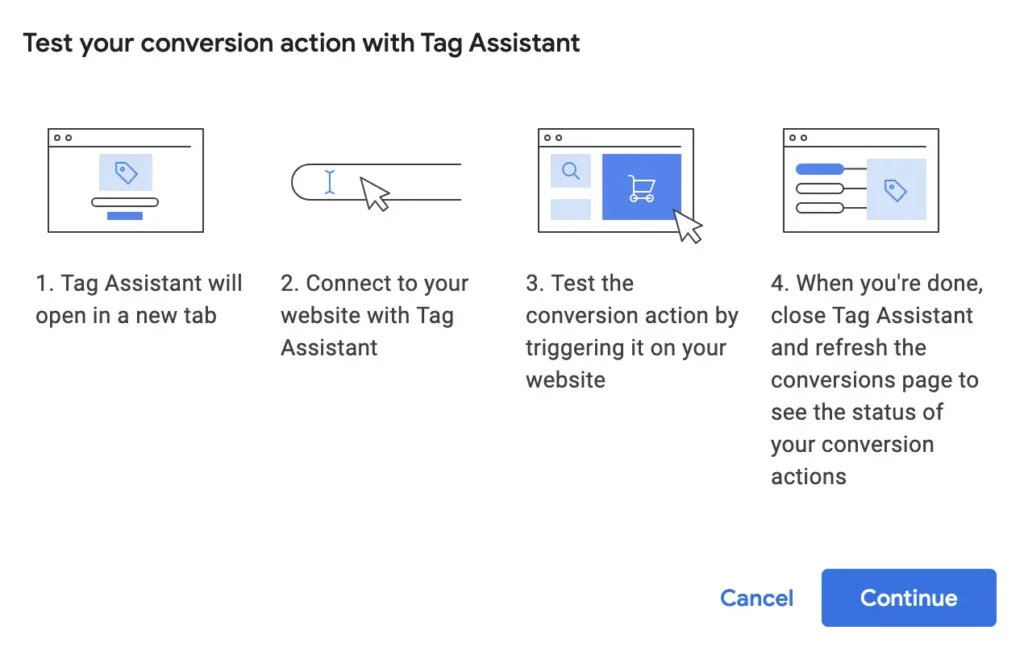
Align Bidding Strategy with Goals
Your bidding strategy must align with your campaign goals. For example, using a target CPA smart bidding strategy isn’t effective if your goal is to maximize the number of conversions. Ensure your objectives are realistic and achievable. If your target ROAS is too high, Google may not be able to meet it, resulting in no conversions.
A/B Testing
Unsure which bidding strategy will work best? Test them out. Run one bidding strategy for a few months without making any changes, then try another with a different goal. This helps you identify the most effective approach.
Once you find a bidding strategy that works, you can start A/B testing your ads to further optimize performance
Avoid Frequent Changes
Regularly evaluating and adjusting your campaigns is important for maximizing conversions and ROI. However, avoid making changes too frequently. Google needs time to optimize your campaigns and bids, especially with automated or smart bidding strategies.
Lift Digitally Paid Bidding Strategies In Action
Now that you understand how bidding strategies work and the best practices to follow, let’s dive into how our team at Lift Digitally has successfully implemented various bidding strategies.
Comprehensive Bid Strategy Adjustments
At times, campaigns require a complete overhaul to yield better results. This was the case with a medical device manufacturer struggling to compete with established players in the search results.
Their account setup was overly complex, with too many ad groups and mixed conversion goals. We decided to simplify everything by consolidating campaigns, focusing on broad match keywords, and optimizing for more valuable online form completions instead of phone calls.
The results were impressive: a 44% increase in patient leads from all paid media channels, a 66% increase in total lead volume, and a 39% decrease in cost per lead
In contrast, another client in the manufacturing sector needed a more tailored approach after losing organic traffic due to a site migration. We created specific audience subgroups, customized ad copy and landing pages for each ad group, and used customer match blacklists to avoid targeting existing customers within 30, 60, and 90-day periods.
This strategy resulted in an 87% year-on-year increase in revenue, a 45% decrease in CPAs, a 68.4% increase in conversion value, and a 22% decrease in CPCs. Remarkably, we achieved a 29x return on ad spend within three weeks.
Automated Bidding Strategies in Action
Automated bidding can greatly enhance efficiency and performance. For an e-commerce client aiming to boost ad performance and reach more customers, we switched to automated bidding across Google, Facebook, and Bing. This simplified their campaigns and ensured foundational elements were in place.
With automated bidding handling the heavy lifting, our team focused on creating new ad creatives to combat ad fatigue and address various customer pain points. The results were significant: a 59% increase in Google conversions, a 153% increase in Facebook conversions, and a 300% increase in Facebook conversion rate.
Smart Bidding in Action
When fast results are needed, smart bidding strategies are often the best choice. For a cloud hosting provider looking to improve conversion rates during client onboarding with a reduced paid search budget, we consolidated their campaigns from 14 to five and combined broad keywords with auction-timed smart bidding.
This strategy allowed our team to craft custom ad copy that emphasized unique value propositions, leading to a 274% increase in conversions across all paid media. Specifically, search campaigns saw a 59% increase in clickthrough rates, a 31% decrease in costs per acquisition, and an 8% increase in conversion rates. Our campaigns also delivered the highest leads at the lowest historical cost.
Portfolio Bidding in Action
Portfolio bidding is an AI-powered strategy that optimizes performance goals across multiple campaigns, ad groups, and keywords. Instead of managing budgets for each campaign individually, a single strategy is applied across all of them, saving time and simplifying management.
For a cloud-based software provider experiencing declining PPC leads and rising costs, we used a combination of portfolio and smart bidding strategies. By applying Google’s Target CPA bidding strategy across all shared budget campaigns, we maintained segmentation efforts while optimizing budget allocation.
The results were remarkable: a 72% increase in leads from Google Ads, a 60% increase in conversion rates, and a 38% decrease in cost-per-lead.
Want to drive better results for your paid campaigns? Learn more about Lift Digitally’s paid offerings and how we can help you achieve your marketing goals.
FAQs Paid Search Bidding Strategies
What is the difference between paid search and PPC?
Paid Search refers to the overall model of search-based advertising, covering all the ads you place on search engines like Google and Bing, and also on other platforms such as Amazon and YouTube.
PPC (Pay-Per-Click) is a specific type of paid search where you pay only when a user clicks on your ad. It’s a way to ensure you’re only charged for actual engagement with your ads.
What is the difference between maximizing clicks and maximizing conversions for bidding?
When you maximize clicks, you instruct Google (or another ad network) to use your budget to attract as many clicks as possible. This strategy focuses on driving traffic to your site, but doesn’t guarantee that those visitors will convert.
Maximizing conversions, however, focuses on using your budget to get as many conversions as possible—actions like purchases or sign-ups. This strategy often results in fewer clicks, but from users who are more likely to convert.
When should I use manual bidding vs. automated bidding strategies?
Automated Bidding is typically the best option if you’re new to search marketing, have limited time to manage campaigns, or aim to achieve broad goals such as maximizing clicks or conversions. Automated strategies adjust bids based on performance data, making campaign management easier.
Manual Bidding is more suitable for experienced marketers who want detailed control over their PPC budget and are willing to invest time in campaign optimization. This approach allows for precise adjustments to individual bids, giving you greater control over your budget allocation
Conclusion
Paid search can help you achieve a variety of objectives, whether it’s boosting e-commerce sales or enhancing brand visibility. The key is to choose the right PPC bidding strategy for your specific goals.
There isn’t a one-size-fits-all strategy; rather, the best approach depends on your unique needs. As demonstrated by the success stories of our clients at Lift Digitally, different bidding strategies can deliver outstanding results.
So, start experimenting with different bidding strategies today to find what works best for you. Alternatively, reach out to our agency to discover how we can help you achieve similar success for your business.

